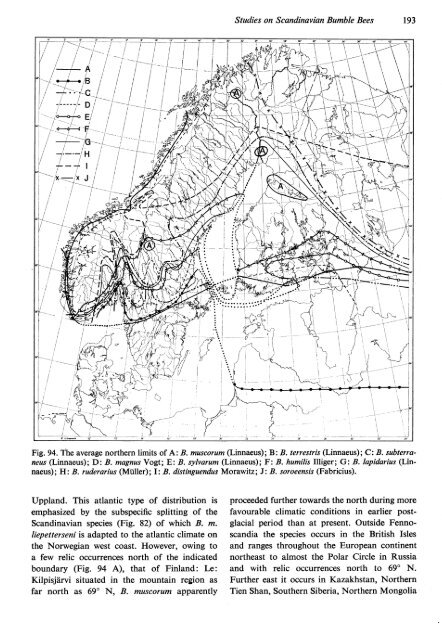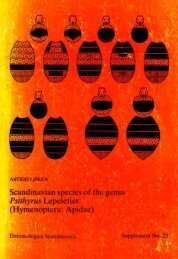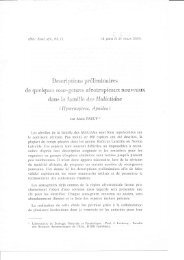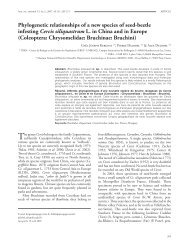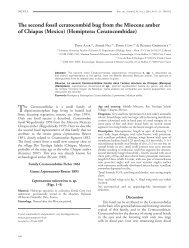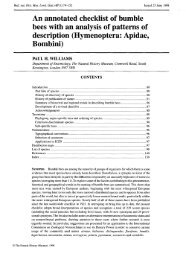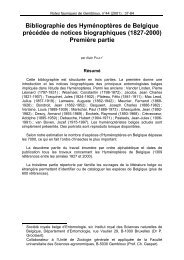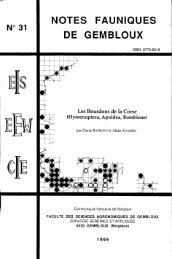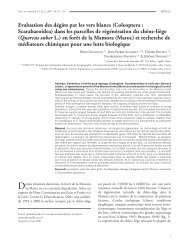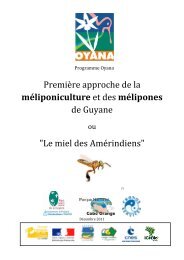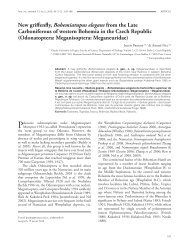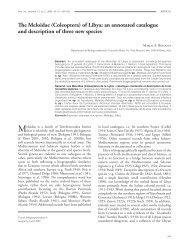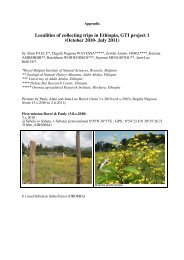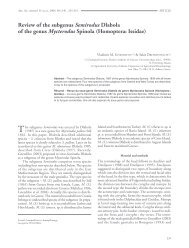- Page 1 and 2:
Z k/ /4.evQ4h,"./Lt:ffNORSK ENTOMOL
- Page 3 and 4:
In memory ofOve Meidell (1 903- 194
- Page 5 and 6:
Studies on Scandinayran Bumble Bees
- Page 7 and 8:
Studies on Scandinavian Bumble Bees
- Page 9 and 10:
Studies on Scandinavian Bumble Bees
- Page 11 and 12:
Studies on Scandinavian Bumble Bees
- Page 13 and 14:
Studies on Scandinavian Bumble Bees
- Page 15 and 16:
Studies on Scandinavian Bumble Bees
- Page 17 and 18:
Studies on Scandinavian Bumble Bees
- Page 19 and 20:
Studies on Scandinavian Bumble Bees
- Page 21 and 22:
Studies on Scandinavian Bumble Bees
- Page 23 and 24:
Studies on Scandinavian Bumble Bees
- Page 25 and 26:
Studies on Scandinavian Bumble Bees
- Page 27 and 28:
Studies on Scandinavian Bumble Bees
- Page 29 and 30:
with a bidentate subapical process(
- Page 31 and 32:
Studies on Scandinavian Bumble Bees
- Page 33 and 34:
Studies on Scandinavian Bumble Bees
- Page 35 and 36:
Studies on Scandinavian Bumble Bees
- Page 37 and 38:
Studies on Scandinavian Bumble Bees
- Page 39 and 40:
Studies on Scandinavian Bumble Bees
- Page 41 and 42:
Studies on Scandinavian Bwmble Rees
- Page 43 and 44:
Studies on Scandinavian Bumble Bees
- Page 45 and 46:
Studies on Scandinavian Bumble Bees
- Page 47 and 48:
Studies on Scandinavian Bumble Bees
- Page 49 and 50:
Studies on Scandinavian Bumble Bees
- Page 51 and 52:
Studies on Scandinavian Bumble Bees
- Page 53 and 54:
8" E.Grenwd 1d 12" 11' 16"Studies o
- Page 55 and 56:
Studies on Scandinavian Bumble Bees
- Page 57 and 58:
Studies on Scandinavtan Bumble Bees
- Page 59 and 60:
Studies on Scandinavian Bumble Bees
- Page 61 and 62:
Studies on Scandinavian Bumble Bees
- Page 63 and 64:
iStudies on Scandinavian Bumble Bee
- Page 65 and 66:
Studies on Scandinavian Bumble Bees
- Page 67 and 68:
IlIlIStudies on Scandinavian Bumble
- Page 69 and 70:
Studies on Scandinavian Bumble Bees
- Page 71 and 72:
Studies on Scandinavian Bumble Bees
- Page 73 and 74:
Studies on Scandinavian Bumble Bees
- Page 75 and 76:
Studies on Scandinat,ictn Bumble Be
- Page 77 and 78:
Studies on Scandinavian Bumble Bees
- Page 79 and 80:
Studies on Scandinavian Bumble Bees
- Page 81 and 82:
Studies on Scandinavian Bumble Bees
- Page 83 and 84:
Studies on Scandinavian Bumble Bees
- Page 85 and 86:
Studies on Scandinavtan Bumble Bees
- Page 87 and 88:
Studies on Scandinavian Bttmble Bee
- Page 89 and 90:
Studies on Scandinavian Bumble Bees
- Page 91 and 92:
Studies on Scandinavian Bumble Bees
- Page 93 and 94:
Studies on Scandinavian Bumble Bees
- Page 95 and 96:
Studies on Scandinavian Bumble Bees
- Page 97 and 98:
Studies on Scandinavian Bumble Bees
- Page 99 and 100:
Studies on Scandinavian Bumble Bees
- Page 101 and 102:
Studies on Scandinavian Bumble Bees
- Page 103 and 104:
Studies on Scandinavian Bumble Bees
- Page 105 and 106:
Studies on Scandinavian Bumble Bees
- Page 107 and 108:
Studies on Scandinavian Bumble Bees
- Page 109 and 110:
Studies on Scandinavian Bumble Bees
- Page 111 and 112:
Studies on Scandinavian Bumble Bees
- Page 113 and 114:
Studies on Scandinavian Bumble Bees
- Page 115 and 116:
Studies on Scandinavian Bumble Bees
- Page 117 and 118:
Studies on Scandinavian Bumble Bees
- Page 119 and 120:
Studies on Scandinavian Bumble Bees
- Page 121 and 122:
Studies on Scandinavian Bumble Bees
- Page 123 and 124:
Studies on Scandinavian Bumble Bees
- Page 125 and 126:
Studies on Scandinavian Bumble Bees
- Page 127 and 128:
Studies on Scandinavian Bumble Bees
- Page 129 and 130:
Studies on Scandinavian Bumble Bees
- Page 131 and 132:
Studies on Scandinavian Bumble Bees
- Page 133 and 134:
t--lt(.- a \gi\J/I-aStudies on Scan
- Page 135 and 136:
Studies on Scandinavian Bumble Bees
- Page 137 and 138:
Studies on Scandinavian Bumble Bees
- Page 139 and 140:
Studies on Scandinavian Bumble Bees
- Page 141 and 142:
Studies on Scandinavian Bumble Bees
- Page 143 and 144:
Studies on Scandinavian Bumble Bees
- Page 145 and 146: Studies on Scandinavian Bumble Bees
- Page 147 and 148: Studies on Scandinavian Bumble Bees
- Page 149 and 150: Studies on Scandinavian Bumble Bees
- Page 151 and 152: Studies on Scandinavian Bumble Bees
- Page 153 and 154: Studies on Scandinavian Bumble Bees
- Page 155 and 156: Studies on Scandinavian Bumble Bees
- Page 157 and 158: Studies on Scandinavian Bumble Bees
- Page 159 and 160: Studies on Scandinavian Bumble Bees
- Page 161 and 162: Studies on Scandinavian Bumble Bees
- Page 163 and 164: Studies on Scandinavian Bumble Bees
- Page 165 and 166: Studies on Scandinavian Bumble Bees
- Page 167 and 168: stad; Meland: Brakstad, Lansvik, Me
- Page 169 and 170: Studies on Scandinavian Bumble Bees
- Page 171 and 172: Studies on Scandtnavian Bumble Bees
- Page 173 and 174: Studies on Scandinavian Bumble Bees
- Page 175 and 176: Studies on Scandinavian Bumble Bees
- Page 177 and 178: Studies on Scandinaviqn Bumble Bees
- Page 179 and 180: Studies on Scandinavian Bumble Bees
- Page 181 and 182: Studies on Scandinavian Bumble Bees
- Page 183 and 184: Studies on Scandinavian Bumble Bees
- Page 185 and 186: on Scandinavian Bumble Bees181Fig.
- Page 187 and 188: Studies on Scandinavian Bumble Bees
- Page 189 and 190: sen), Time: ? loc. H TRM; Kvitsoy:
- Page 191 and 192: Studies on Scandinavian Bumble Bees
- Page 193 and 194: Studies on Scandinavian Bumble Bees
- Page 195: Studies on Scandinavian Bumble Bees
- Page 199 and 200: Studies on Scandinavian Bumble Bees
- Page 201 and 202: Studies on Scandinavian Bumble Bees
- Page 203 and 204: Studies on Scandinavian Bumble Bees
- Page 205 and 206: Studies on Scandinavian Bumble Bees
- Page 207 and 208: Studies on Scandinavian Bumble Bees
- Page 209 and 210: Studies on Scandinavian Bumble Bees
- Page 211 and 212: Studies on Scandinavian Bumble Bees
- Page 213 and 214: Studies on Scandinavian Bumble Bees
- Page 215 and 216: Studies on Scandinavian Bumble Bees
- Page 217 and 218: Studies on Scandinavian Bumble Bees
- Page 219 and 220: Studies on Scandinavian Bumble Bees
- Page 221 and 222: Studies on Scandinavian Bumble Bees
- Page 223: A free drawing by G. Langhelle, fro


